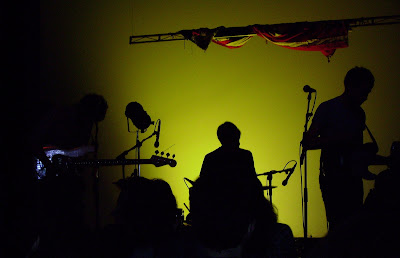
If you didn't think 60 years was a long time, perhaps a conversation with Lee Konitz would change your mind. The altoist who got a big break in 1949 playing on Miles Davis' Birth of the Cool has been pushing boundaries and exploring the limits of jazz's West Coast ever since. And on a night dedicated to deconstructing familiar tunes, Konitz' trio picked standards apart and left them that way. The renditions were loose quilts whose strings were never tied up at the edges.
It was a treat to hear drummer Paul Motian, the reigning king of colorists, hint at polyrhythms by playing their every third or fourth note rather than hammering them down listeners' throats. He didn't break into a swing -- or any consistent drumbeat -- until the last tune of the first set, and even then his rhythm was minimalist and beautifully hollowed-out. But it was pianist Dan Tepfer who stole the show, demonstrating such natural restraint that he was loath to spend more than a few measures playing chords. Tepfer largely stuck to two-handed octave lines and dissonant patterns, painting circles around Konitz' tired, restless, on-again off-again sketches.
Saturday night's performance, the last of a four-night run at New York's Birdland jazz club, was a conversation in the truest sense of the word, and the dialogue between Konitz and Tepfer held the night's most explorative subplot. The bandleader rarely lay out for more than eight bars at a time, but he didn't spend four minutes wailing away while the others comped, either. In fact, no one took a traditional, extended solo all night. In this conversation, everyone's contributions were equally important; speakers hesitated to listen to each other but interjected at will. It was a lilting, collectivist free that brought the egalitarian vision of Motian's old boss, Bill Evans, into striking new territory.
Many in the audience were completely blindsided. They were not expecting a "Stella by Starlight" so sketchily rendered that the melody was almost impossible to place, or an entire set in which any combination of piano, bass, drums, or saxophone was equally likely. Dinner conversations continued well into the first half of the set, and many of those gazing around the room were as exasperated as they were unmoved. But by the time late in the evening when Konitz announced, more than a touch idiosyncratically, that the band would do some "free play," the faces were all rapt, focused on the stage.
The conversation wasn't easy to penetrate, but as the quartet gained locomotion, listeners grasped what was between each lethargic, halting phrase and the heedful responses that tumbled into one another with an unforeseeable logic. As the final tune drew to a close, Tepfer wandered into a solo piano improvisation of high, Ethan Iversonesque three-note arpeggios and a slow, scale-bending melody in the left hand. Again and again, Tepfer showed a finesse and deference to melody that Motian might have recognized as largely reminiscent of Keith Jarrett.
Saturday night found Konitz, one of the the oldest masters of counter-bop, renegotiating post-bop's language. If this prerogative didn't seem immediately logical, the quartet's interactive mastery eventually made it so.














